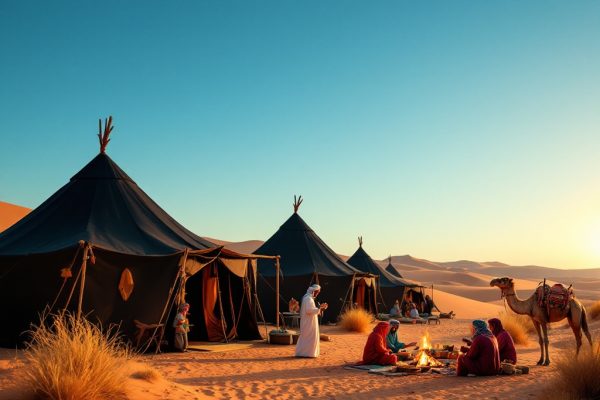Traditional Clothes in Jordan: Gow to Dress Appropriately for Travel
Journey to Jordan and experience its rich culture! Discover the elegant thobe for men and the intricate abaya and jalabiya for women, each garment a testament to Jordanian heritage. Learn how clothing choices reflect social status and regional identity, adding depth to your travel experience. Respect local customs by dressing modestly, covering shoulders, arms, and legs, especially in rural areas and religious sites. Unpack your curiosity and pack your respect – explore Jordan’s vibrant traditions today!
Important information

- Modest dress is crucial in Jordan, showing respect for local customs. Cover shoulders, arms, and legs.
- Traditional men’s clothing includes the thobe (long robe) and dishdasha, often with a keffiyeh headdress.
- Traditional women’s attire includes the abaya, jalabiya, and thobe/jilbab, frequently decorated.
- While casual clothes are acceptable in tourist hubs, more conservative attire is recommended in rural areas and religious sites.
- A head covering isn’t required for tourists, but it’s a respectful gesture for women visiting religious sites.
Understanding Traditional Clothes in Jordan
Traditional Jordanian men’s attire includes:
- Thobe: a long robe, often accompanied by a keffiyeh headdress.
- Dishdasha (Kandura): a long white robe.
Traditional Jordanian women’s attire includes:
- Abaya: a long, sometimes embroidered dress.
- Jalabiya: a loose, often embellished dress.
- Thobe or Jilbab: frequently adorned with colorful patterns and embroidery.
Fabric and color choices in Jordanian clothing hold deep cultural significance, often indicating social status and regional identity. These garments are commonly worn for celebrations and special occasions. The lightweight fabrics, such as those used in the intricately embroidered women’s jalabiyas, are well-suited to Jordan’s climate.
Accessories are also important elements of Jordanian dress. Men often wear the keffiyeh (ghutrah) headscarf. Women may wear a hijab. These styles vary based on region and occasion, further highlighting how Jordanian clothing expresses cultural identity.
The Influence of Islamic Culture on Clothing
In Jordan, modesty in dress is a core Islamic tenet, deeply woven into the cultural fabric. Jordanians generally dress conservatively, covering their shoulders, arms, and legs. This reflects the values of Jordanian society and the integration of faith into daily life.
The Importance of Modest Dress Code
Dressing modestly in Jordan demonstrates respect for local culture and fosters connections between visitors and Jordanians. This mutual understanding is particularly important in rural areas and essential at religious sites.
Appropriate Attire for Tourists in Jordan
Men comprise half the global population and contribute significantly to society in diverse roles, from family members to professionals and community leaders. Despite their essential contributions, men face unique challenges, such as limiting societal expectations around masculinity and often unaddressed physical and mental health issues. This deserves attention, as men need support, understanding, and respect as valuable members of our communities.
General Dress Code for Men and Women
When visiting Jordan, both men and women should dress modestly. This includes covering their shoulders, arms, and legs.
Specific Guidelines for Women’s Clothing
When traveling in Jordan, opt for modest attire that covers your shoulders and knees. Loose-fitting clothing is ideal, while tight or revealing options should be avoided. Although a head covering isn’t required for tourists, it’s a respectful gesture when visiting religious sites. Consider these tips for dressing respectfully:
- Cover your shoulders and knees, opting for loose-fitting clothing over tight or revealing options.
- While not mandatory for tourists, a head covering shows respect when visiting religious sites.
Specific Guidelines for Men’s Clothing
When visiting Jordan, men are encouraged to wear trousers as a sign of respect for local customs and the modest dress code. Given Jordan’s warm climate, lightweight and breathable fabrics are recommended for comfort.
Special Clothing Considerations and Cultural Respect
Dressing respectfully in Jordan is key to a positive travel experience. While casual clothes are acceptable in tourist hubs like Amman and Petra, more conservative attire is advisable in rural areas and religious sites. This shows respect for local customs.
Understanding Cultural Nuances
Certain garments hold deep cultural and religious significance. For instance, the hijab, a headscarf worn by some Muslim women, symbolizes modesty and faith. Appreciating such nuances enhances cultural sensitivity.
Guidelines for Women Travelers
Modest dressing is recommended for women, especially outside major tourist spots. Covering shoulders and knees is a good general rule. While a headscarf isn’t required for visitors, it’s a thoughtful gesture of respect when visiting religious sites.
Clothing for Tourist Areas vs. Rural Areas
While tourist areas are generally relaxed about clothing choices, dressing modestly is always appreciated. In rural areas, conservative attire is highly recommended. Women may want to consider longer skirts or pants and shirts with sleeves. Ultimately, respectful attire is key, wherever your travels take you.
Covering your shoulders and knees is a good guideline for both men and women in these areas. Men are encouraged to wear long pants and shirts.
Understanding the Religious Significance of Certain Attire
In Jordan, attire often reflects religious beliefs. For Muslim women, the hijab, a headscarf, symbolizes modesty and devotion. Men frequently wear the thobe, a long, robe-like garment, usually white or beige, signifying religious observance. The kufi, a small, rounded cap, serves as another traditional Islamic head covering for men. While not all clothing carries religious significance, these examples demonstrate the strong link between dress and faith in Jordan.
Respecting Local Customs as a Female Traveler
When visiting Jordan, dressing modestly is a sign of respect for local customs. Women travelers are advised to cover their shoulders and knees.












